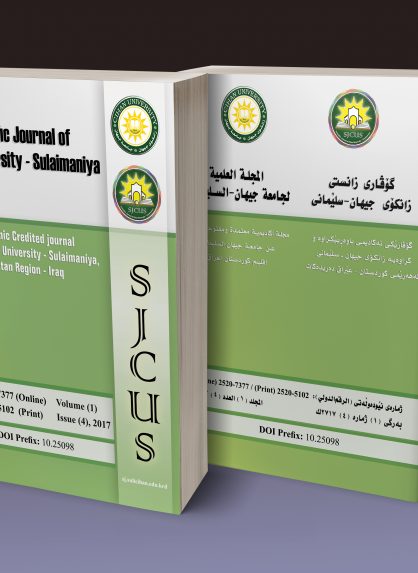| published |
| DOI
http://dx.doi.org/10.25098/2.2.31 |
Mukhalad Malik
Department of English, Cihan Unversity-Slemani, Kurdistan Region , Iraq
Assist. Lecturer: Aras Abdalkarim
Department of English, Cihan Unversity-Slemani , Kurdistan Region , Iraq
Received : 5-1-2018 Revised:13-2-2018
Accepted :14-2-2018 Published :31-12-2018
Abstract
The current paper is an attempt to verify and demonstrate the significance of the use of non-literal idiomatic expressions in communication within a theoretical framework. Being an essential part of the use of language, the paper shows that the use of such idiomatic expressions is vital in various communicative situations due to a lot of reasons. This is achieved throughout the paper by mainly focusing on the linguistic level through which the idiomatic expressions of non-literal use are realized. Then, it shows the various possible meanings, ideas and messages which they may convey through the various linguistic forms in which they are reflected (such as phrases, fixed idioms, proverbs and so on). Finally, the paper sheds light on the significance of the use of those expressions in communication throughout demonstrating the fact that they are actually used in daily life communication and the major role they play in influencing the entire communication event.
Key words: idiomatic expressions, non-literal, use, communication, influence
پوخته
ئهم توێژینهوهیه ههوڵێكه بۆ سهلماندن و نیشاندانی گرنگی بهكارهێنانی زاراوه ناحهرفیهكان له پهیوهندیهكان له چوارچێوهیهكی تیۆری. ئهم توێژینهوهیه ئهوه نیشان دهدات كه بهكارهێنانی زاراوه ئیدیهماتیكیهكان له چهند شوێنی جیاوازی پهیوهندیهكان، لهبهر چهند هۆكارێكی جیاواز. بۆئهم مهبهسته له ڕێگهی ئهم توێژینهوهیه بهشێوهیهكی سهرهكی ههوڵ دهدرێت جهخت له ئاستی زمانهوانی بكرێتهوه له بهكارهێنانی ئهم زاراوانه به شێوهیهكی ناحهرفی. له دوایدا ئهم توێژینهوهیه مانا و بیرۆكه و پهیامه جیاوازیهكان نیشان دهدات كه له شێوهی زاراوهی زمانهوانی وهكو فرێز و ئیدیهمه نەگۆڕەكان و پهندهكان ڕهنگی داوهتهوه. له كۆتایدا ئهم توێژینهوهیه جهخت له گرنگی بهكارهێنانی ئهم زاراوانه دهكاتهوه كه له پهیوهندیهكان دهردهبڕدرێن له ڕێگهی نیشاندانی ڕاست و دروستی بهكارهێنانیان له پهیوهندی ڕۆژانه و گێڕانی ڕۆڵی سهرهكی كاریگهر له ههموو پهیوهندیهكان.
الملخص
يُعد البحث الحالي محاولة للتحقق و لأثبات مغزى استخدام التعابير الاصطلاحية ذات الدلالات الغير حرفية
باطار نظري. ولأن استخدام هذه التعابير في اللغة و التواصل هو جزء اساسي فان البحث يبين أن استخدامها حيوي في مختلف مواقف الاتصال للعديد من الاسباب. ويتحقق ذلك من خلال التركيز على المستوى و التحليل اللغوي الخاص بهذه المصطلحات. و بعد ذلك يبين المعاني المحتملة العديدة و الافكار و الرسائل التي من الممكن أن تنقلها التعابيرالصطلاحية الغير حرفية من خلال الاشكل اللغوية المتعددة التي تتخذها (مثل العبارات و المصطلحات الثابتة و الامثلة و غير ذلك). واخيرا فان البحث يسلط الضوء على مغزى استخدام هذه التعابير في التواصل من خلال اثبات حقيقة أنها تُستخدم في مواقف الحياة اليومية و كذلك أثبات دورها الرئيسي في التأثير على مُجمل عملية التواصل.
References
- Ambrose, J. (2009). Why Idioms Are Important For English Language Learners. Mikolaiv State Pedagogical University.
- Andreou, G & Galantomos, I. (2009). “Teaching idioms in a Foreign Language Context: Preliminary Comments on Factors Determining Greek Idiom Instruction“. Metaphoric.de. 15, 2-20.
- Ariel, M. (2002). The demise of unique concept of literal meaning. Journal of Pragmatics 34, 361–402.
- Ayto, John (ed.). (2005). Oxford Dictionary of English Idioms. Great Britain: SPI Publisher Services.
- Baker, M. (1992). In Other Words: A Course Book on Translation. London:
- Bell, R.T. (1991). Translation and translating: theory and practice. London: Longman Group.
- Crystal, D. (2008). A Dictionary of Linguistics and Phonetics (6th ed.). Oxford: Blackwell Publishing.
- Fernando, C. (1996). Idioms and Idiomacity. London: Penguin Books.
- Fromkin, V., Rodman, R. & Hyms, N. (2003). An Introduction to Language. United States: Heinle Thomson Corporation.
- Gramley, Stephan, Patzold, Kurt-Michael (1992). A Survey of Modern English, London: Routledge.
- Maftoon, P. & Mazloomi, S. (2009). Classified Idioms. Iran: Rahnama Press.
- Meryem, M. (2009). Problems of Idioms in Translation Case Study: First Year Master. Unpublished M.A. Thesis, Mentouri UniversityRepublic of Algeria.
- Newmark, P.( 1988). A Textbook of Translation. New York: Prentice Hall. Oxford dictionary of idioms.
- O’ Dell, F. & McCarthy, M. (2010). English Idioms in Advanced Use. Cambridge University Press.
- Sporleder, C. and L. Li (2009). Unsupervised Recognition of Literal and Non-literal Use of Idiomatic Expressions. In EACL ’09: Proceedings of the 12th Conference of the European Chapter of the Association for Computational Linguistics, Morristown, NJ, USA, pp. 754–762. Association for Computational Linguistics.
- (Wright, Jon. (1555). Idioms Organizer: Organized by metaphor, topic and key word. UK: Heinle.
.
.



